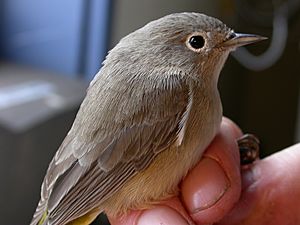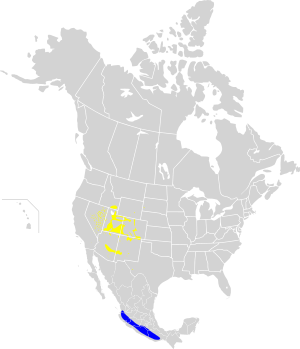Virginia's warbler facts for kids
Quick facts for kids Virginia's warbler |
|
|---|---|
 |
|
| female | |
| Conservation status | |
| Scientific classification | |
| Genus: |
Leiothlypis
|
| Species: |
virginiae
|
 |
|
Summer Winter |
|
| Synonyms | |
|
Vermivora virginiae |
|
The Virginia's warbler (Leiothlypis virginiae) is a small, colorful bird. It belongs to a group called New World warblers.
Even though its name is "Virginia's warbler," it is not named after the state of Virginia. This bird usually lives in the western parts of the United States. Its home range goes as far east as Texas. You can often find it in the mountains of central and southern Colorado, central Wyoming, and central and western New Mexico.
The bird was named after Virginia Anderson. She was the wife of an army surgeon who found the bird. He discovered it at Fort Burgwin, New Mexico, in 1858. Later, in 1860, Spencer Fullerton Baird from the Smithsonian Institution officially described the bird. He decided to name it "Virginia" to honor the wishes of the person who found it.
Contents
What Does Virginia's Warbler Look Like?
Virginia's warbler is a small bird. It is about 4 to 4.5 inches (100 to 114 mm) long. Its body is mostly gray. It has a lighter belly and a white ring around its eye. The feathers near its tail and under its tail are yellow.
- It has a yellow patch on its chest.
- It also has a hidden dark reddish patch on its head.
- Female warblers are a bit duller in color. They have less yellow on their chest.
It can be hard to tell Virginia's warbler apart from the rare Colima warbler. However, Virginia's warbler is smaller. It also has more yellow on its rump. The Colima warbler does not have the yellow chest patch.
Where Do Virginia's Warblers Live?
Virginia's warblers like to live in thick oak and pinyon forests. They also like brushy hillsides near streams. They are found at high places, from 6,000 to 9,000 feet (1,800 to 2,700 meters) above sea level.
Migration and Winter Homes
These birds spend their summers in the southwestern United States. When winter comes, they migrate south. Some travel as far as Belize. They also stop at several Caribbean islands. These islands include the Bahamas, Cuba, and the Turks and Caicos Islands.
Nesting and Reproduction
Virginia's warblers build their nests on the ground. They hide them among dead leaves and clumps of grass. The nests are usually at the bottom of a small bush or young tree.
- The nest is shaped like a cup.
- It is made from moss, grass, strips of bark, and roots.
- The female bird lays between three and five eggs.
- The eggs are white with small brown speckles.
- Both the male and female birds take care of the young.
- We do not know much about how long the eggs take to hatch.
See also
 In Spanish: Reinita de Virginia para niños
In Spanish: Reinita de Virginia para niños


